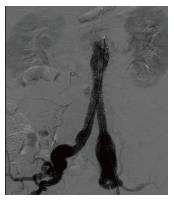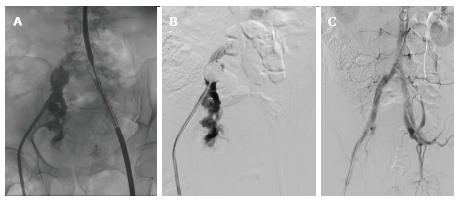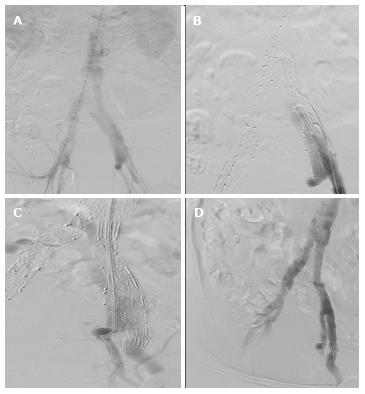Copyright
©The Author(s) 2016.
World J Radiol. Mar 28, 2016; 8(3): 275-280
Published online Mar 28, 2016. doi: 10.4329/wjr.v8.i3.275
Published online Mar 28, 2016. doi: 10.4329/wjr.v8.i3.275
Figure 1 A 73-year-old patient with abdominal aortic aneurysm and bilateral common iliac artery aneurysm treated with flared limb (“Bell-Bottom” technique).
Figure 2 Zenith branch iliac stent grafts.
Straight-side iliac branch device.
Figure 3 A 68-year-old male with an abdominal aortic aneurysm and an iliac artery aneurysm.
A: Preoperative angiography; B: Control angiography after the placement of an Advanta stent graft in the left internal iliac artery without endoleak; C: Control angiography after the deployment of IBD and a bifurcated stent graft; D: Computed tomography angiography and three dimensional reconstruction at 3 mo. IBD: Iliac branch device.
Figure 4 Rupture of the right external iliac artery during manipulation.
A, B: Partially deployed IBD on the left side. An occlusive balloon placed in the right common iliac artery. Angiography revealed the rupture site at the proximal part of the external iliac artery; C: Control angiography following placement of the two fluency stent grafts on the right side, and completion of the procedure with the placement of an IBD device on the left side. IBD: Iliac branch device.
Figure 5 Bilaterally placed branch stent graft.
A, B: Control angiography with endoleak type 3 on the left side; C: Transbrachial access and placement of an additional stent graft; D: Final control angiography featuring a good result and without endoleak.
- Citation: Duvnjak S. Endovascular treatment of aortoiliac aneurysms: From intentional occlusion of the internal iliac artery to branch iliac stent graft. World J Radiol 2016; 8(3): 275-280
- URL: https://www.wjgnet.com/1949-8470/full/v8/i3/275.htm
- DOI: https://dx.doi.org/10.4329/wjr.v8.i3.275













